Organisational Behaviour at Morrisons: Culture, Motivation & Teams
VerifiedAdded on 2023/06/18
|14
|3973
|195
Report
AI Summary
This report provides an analysis of organisational behaviour, focusing on the impact of politics, culture, and power on individual and company performance within Morrisons, a supermarket chain. It evaluates content and process theories of motivation, examining how motivational techniques can enable effective goal achievement. The report also differentiates between effective and ineffective teams, highlighting key skills and characteristics. Furthermore, it applies organisational behaviour concepts and philosophies to the Morrisons context, exploring organisational culture, politics, and power dynamics, and their effects on employee behaviour and overall organisational success. Desklib offers a platform for students to access similar solved assignments and past papers.
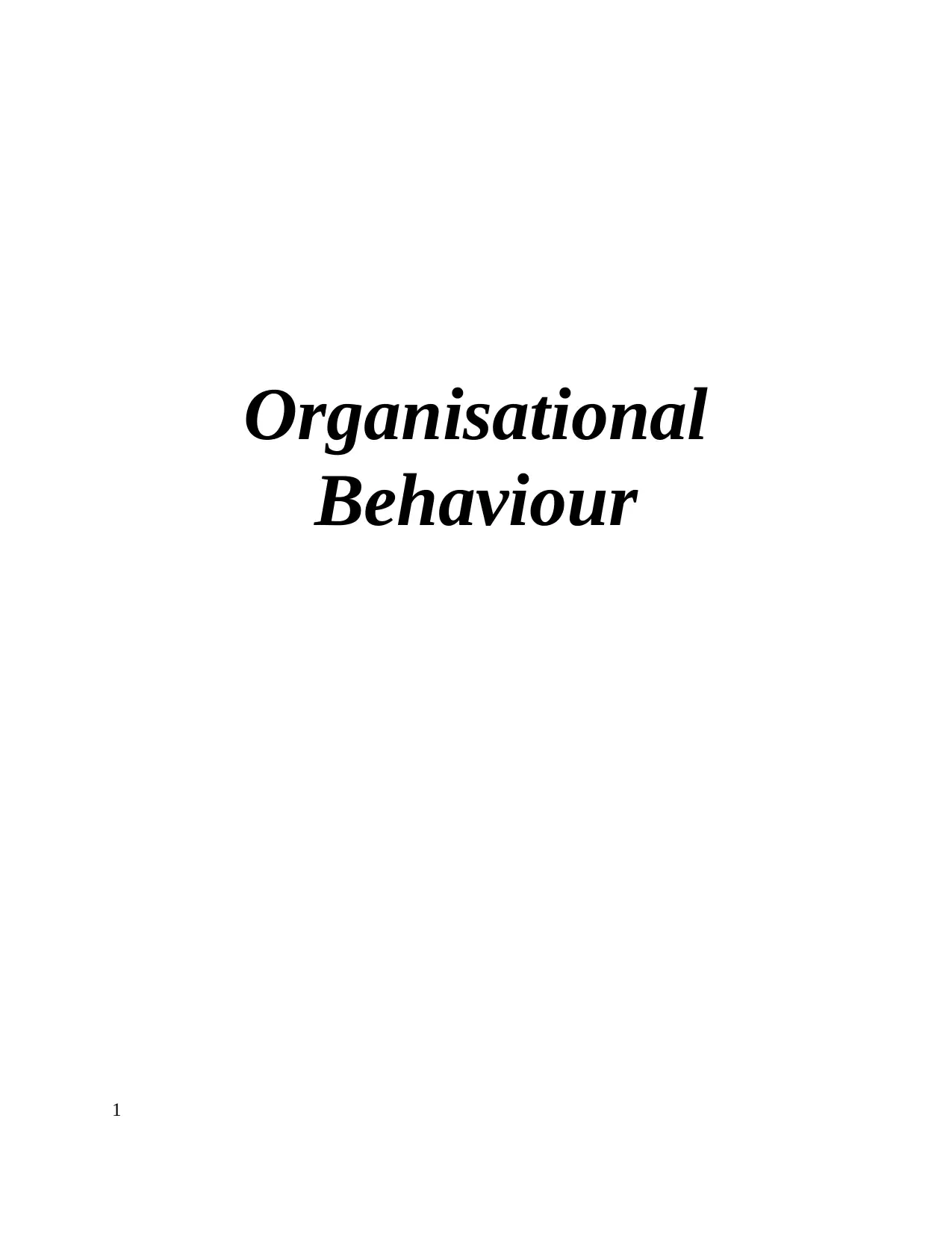
Organisational
Behaviour
1
Behaviour
1
Paraphrase This Document
Need a fresh take? Get an instant paraphrase of this document with our AI Paraphraser
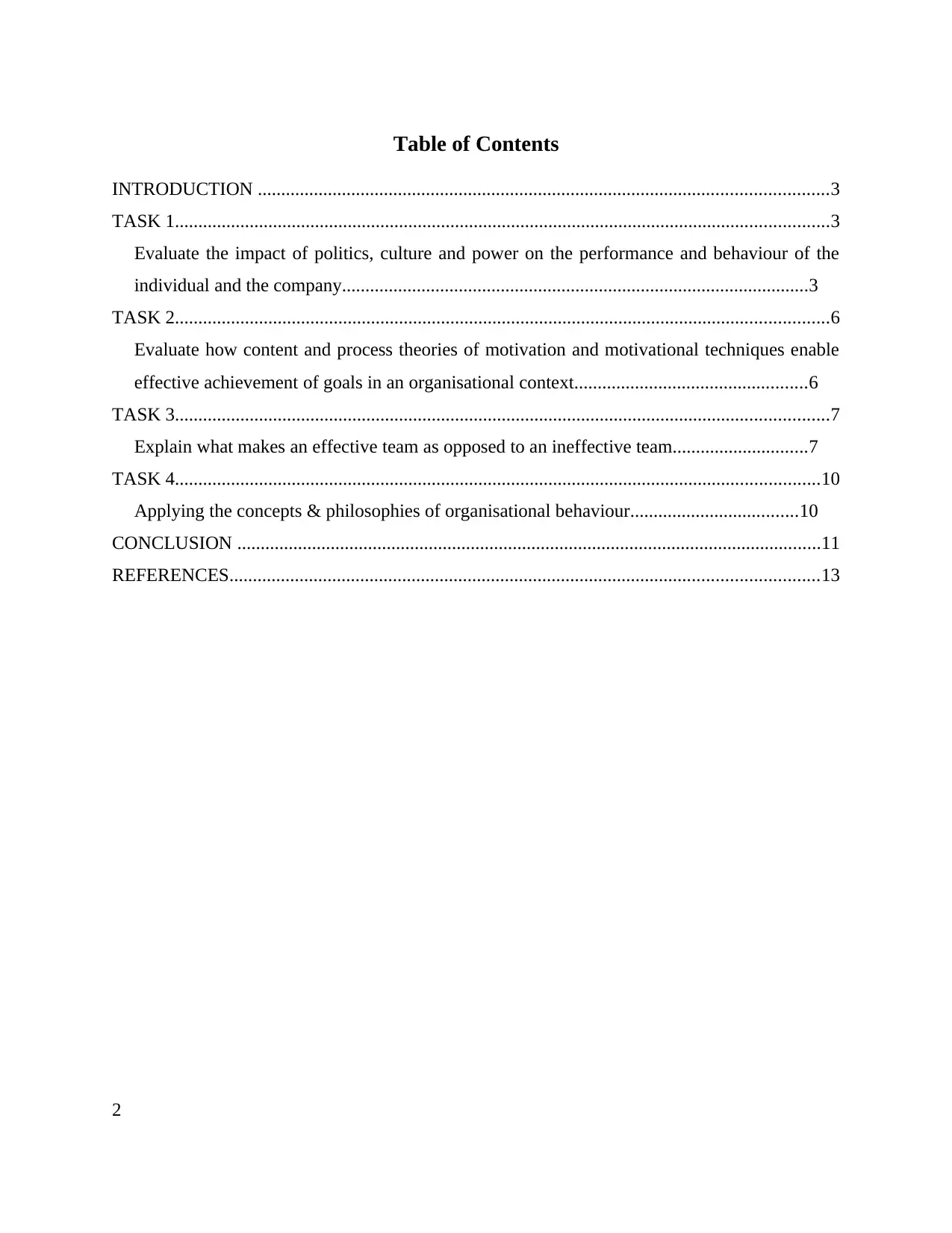
Table of Contents
INTRODUCTION ..........................................................................................................................3
TASK 1............................................................................................................................................3
Evaluate the impact of politics, culture and power on the performance and behaviour of the
individual and the company....................................................................................................3
TASK 2............................................................................................................................................6
Evaluate how content and process theories of motivation and motivational techniques enable
effective achievement of goals in an organisational context..................................................6
TASK 3............................................................................................................................................7
Explain what makes an effective team as opposed to an ineffective team.............................7
TASK 4..........................................................................................................................................10
Applying the concepts & philosophies of organisational behaviour....................................10
CONCLUSION .............................................................................................................................11
REFERENCES..............................................................................................................................13
2
INTRODUCTION ..........................................................................................................................3
TASK 1............................................................................................................................................3
Evaluate the impact of politics, culture and power on the performance and behaviour of the
individual and the company....................................................................................................3
TASK 2............................................................................................................................................6
Evaluate how content and process theories of motivation and motivational techniques enable
effective achievement of goals in an organisational context..................................................6
TASK 3............................................................................................................................................7
Explain what makes an effective team as opposed to an ineffective team.............................7
TASK 4..........................................................................................................................................10
Applying the concepts & philosophies of organisational behaviour....................................10
CONCLUSION .............................................................................................................................11
REFERENCES..............................................................................................................................13
2
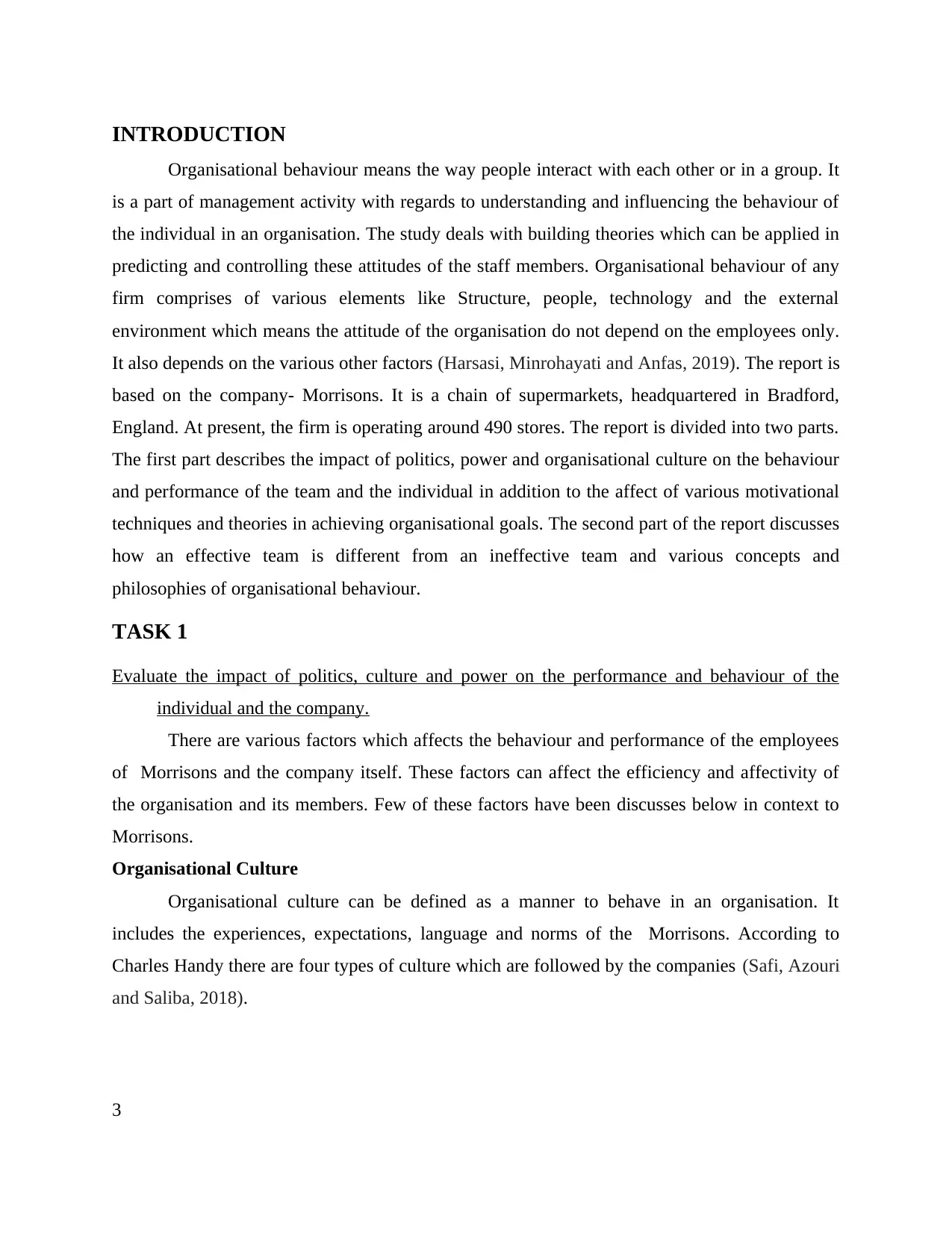
INTRODUCTION
Organisational behaviour means the way people interact with each other or in a group. It
is a part of management activity with regards to understanding and influencing the behaviour of
the individual in an organisation. The study deals with building theories which can be applied in
predicting and controlling these attitudes of the staff members. Organisational behaviour of any
firm comprises of various elements like Structure, people, technology and the external
environment which means the attitude of the organisation do not depend on the employees only.
It also depends on the various other factors (Harsasi, Minrohayati and Anfas, 2019). The report is
based on the company- Morrisons. It is a chain of supermarkets, headquartered in Bradford,
England. At present, the firm is operating around 490 stores. The report is divided into two parts.
The first part describes the impact of politics, power and organisational culture on the behaviour
and performance of the team and the individual in addition to the affect of various motivational
techniques and theories in achieving organisational goals. The second part of the report discusses
how an effective team is different from an ineffective team and various concepts and
philosophies of organisational behaviour.
TASK 1
Evaluate the impact of politics, culture and power on the performance and behaviour of the
individual and the company.
There are various factors which affects the behaviour and performance of the employees
of Morrisons and the company itself. These factors can affect the efficiency and affectivity of
the organisation and its members. Few of these factors have been discusses below in context to
Morrisons.
Organisational Culture
Organisational culture can be defined as a manner to behave in an organisation. It
includes the experiences, expectations, language and norms of the Morrisons. According to
Charles Handy there are four types of culture which are followed by the companies (Safi, Azouri
and Saliba, 2018).
3
Organisational behaviour means the way people interact with each other or in a group. It
is a part of management activity with regards to understanding and influencing the behaviour of
the individual in an organisation. The study deals with building theories which can be applied in
predicting and controlling these attitudes of the staff members. Organisational behaviour of any
firm comprises of various elements like Structure, people, technology and the external
environment which means the attitude of the organisation do not depend on the employees only.
It also depends on the various other factors (Harsasi, Minrohayati and Anfas, 2019). The report is
based on the company- Morrisons. It is a chain of supermarkets, headquartered in Bradford,
England. At present, the firm is operating around 490 stores. The report is divided into two parts.
The first part describes the impact of politics, power and organisational culture on the behaviour
and performance of the team and the individual in addition to the affect of various motivational
techniques and theories in achieving organisational goals. The second part of the report discusses
how an effective team is different from an ineffective team and various concepts and
philosophies of organisational behaviour.
TASK 1
Evaluate the impact of politics, culture and power on the performance and behaviour of the
individual and the company.
There are various factors which affects the behaviour and performance of the employees
of Morrisons and the company itself. These factors can affect the efficiency and affectivity of
the organisation and its members. Few of these factors have been discusses below in context to
Morrisons.
Organisational Culture
Organisational culture can be defined as a manner to behave in an organisation. It
includes the experiences, expectations, language and norms of the Morrisons. According to
Charles Handy there are four types of culture which are followed by the companies (Safi, Azouri
and Saliba, 2018).
3
⊘ This is a preview!⊘
Do you want full access?
Subscribe today to unlock all pages.

Trusted by 1+ million students worldwide
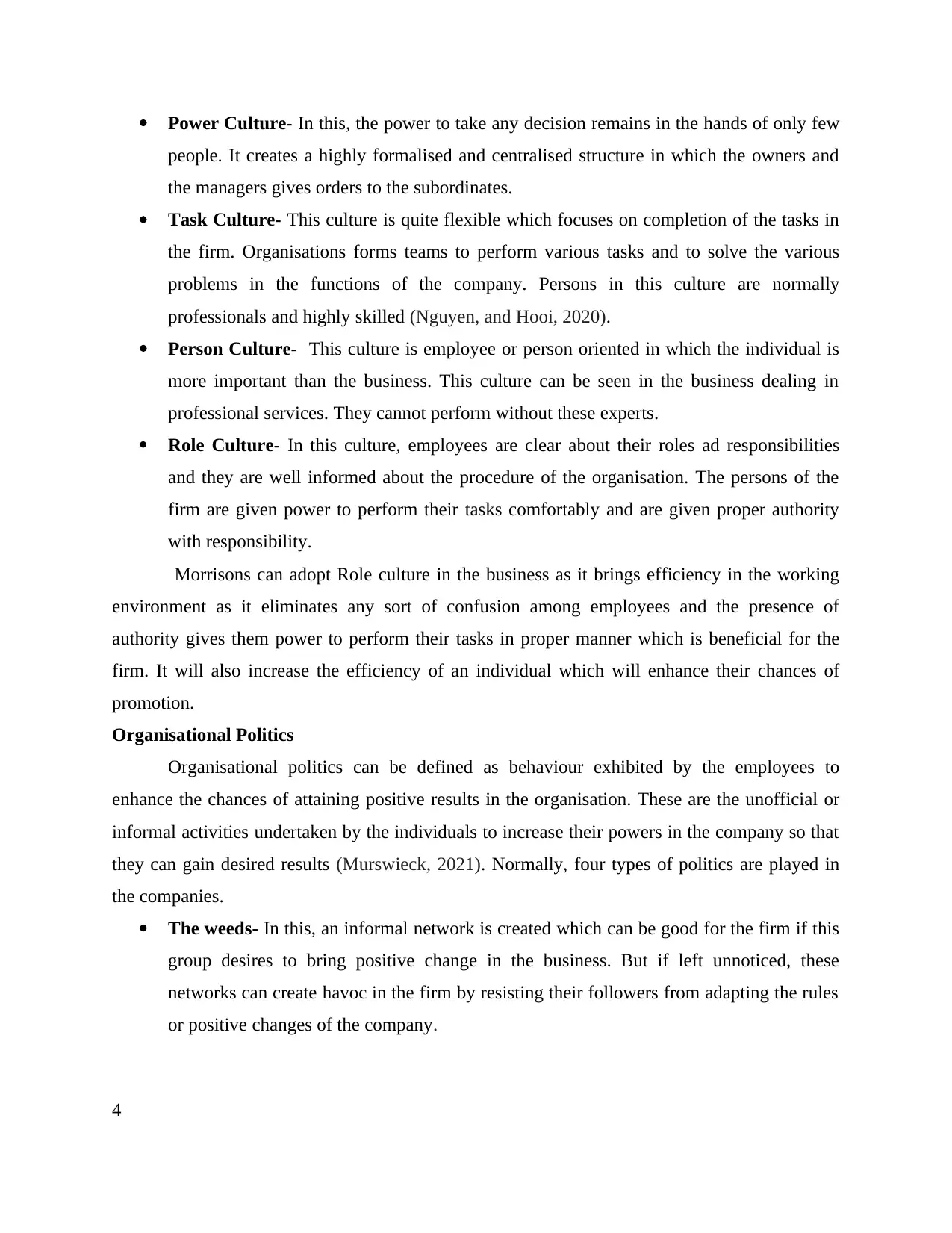
Power Culture- In this, the power to take any decision remains in the hands of only few
people. It creates a highly formalised and centralised structure in which the owners and
the managers gives orders to the subordinates.
Task Culture- This culture is quite flexible which focuses on completion of the tasks in
the firm. Organisations forms teams to perform various tasks and to solve the various
problems in the functions of the company. Persons in this culture are normally
professionals and highly skilled (Nguyen, and Hooi, 2020).
Person Culture- This culture is employee or person oriented in which the individual is
more important than the business. This culture can be seen in the business dealing in
professional services. They cannot perform without these experts.
Role Culture- In this culture, employees are clear about their roles ad responsibilities
and they are well informed about the procedure of the organisation. The persons of the
firm are given power to perform their tasks comfortably and are given proper authority
with responsibility.
Morrisons can adopt Role culture in the business as it brings efficiency in the working
environment as it eliminates any sort of confusion among employees and the presence of
authority gives them power to perform their tasks in proper manner which is beneficial for the
firm. It will also increase the efficiency of an individual which will enhance their chances of
promotion.
Organisational Politics
Organisational politics can be defined as behaviour exhibited by the employees to
enhance the chances of attaining positive results in the organisation. These are the unofficial or
informal activities undertaken by the individuals to increase their powers in the company so that
they can gain desired results (Murswieck, 2021). Normally, four types of politics are played in
the companies.
The weeds- In this, an informal network is created which can be good for the firm if this
group desires to bring positive change in the business. But if left unnoticed, these
networks can create havoc in the firm by resisting their followers from adapting the rules
or positive changes of the company.
4
people. It creates a highly formalised and centralised structure in which the owners and
the managers gives orders to the subordinates.
Task Culture- This culture is quite flexible which focuses on completion of the tasks in
the firm. Organisations forms teams to perform various tasks and to solve the various
problems in the functions of the company. Persons in this culture are normally
professionals and highly skilled (Nguyen, and Hooi, 2020).
Person Culture- This culture is employee or person oriented in which the individual is
more important than the business. This culture can be seen in the business dealing in
professional services. They cannot perform without these experts.
Role Culture- In this culture, employees are clear about their roles ad responsibilities
and they are well informed about the procedure of the organisation. The persons of the
firm are given power to perform their tasks comfortably and are given proper authority
with responsibility.
Morrisons can adopt Role culture in the business as it brings efficiency in the working
environment as it eliminates any sort of confusion among employees and the presence of
authority gives them power to perform their tasks in proper manner which is beneficial for the
firm. It will also increase the efficiency of an individual which will enhance their chances of
promotion.
Organisational Politics
Organisational politics can be defined as behaviour exhibited by the employees to
enhance the chances of attaining positive results in the organisation. These are the unofficial or
informal activities undertaken by the individuals to increase their powers in the company so that
they can gain desired results (Murswieck, 2021). Normally, four types of politics are played in
the companies.
The weeds- In this, an informal network is created which can be good for the firm if this
group desires to bring positive change in the business. But if left unnoticed, these
networks can create havoc in the firm by resisting their followers from adapting the rules
or positive changes of the company.
4
Paraphrase This Document
Need a fresh take? Get an instant paraphrase of this document with our AI Paraphraser
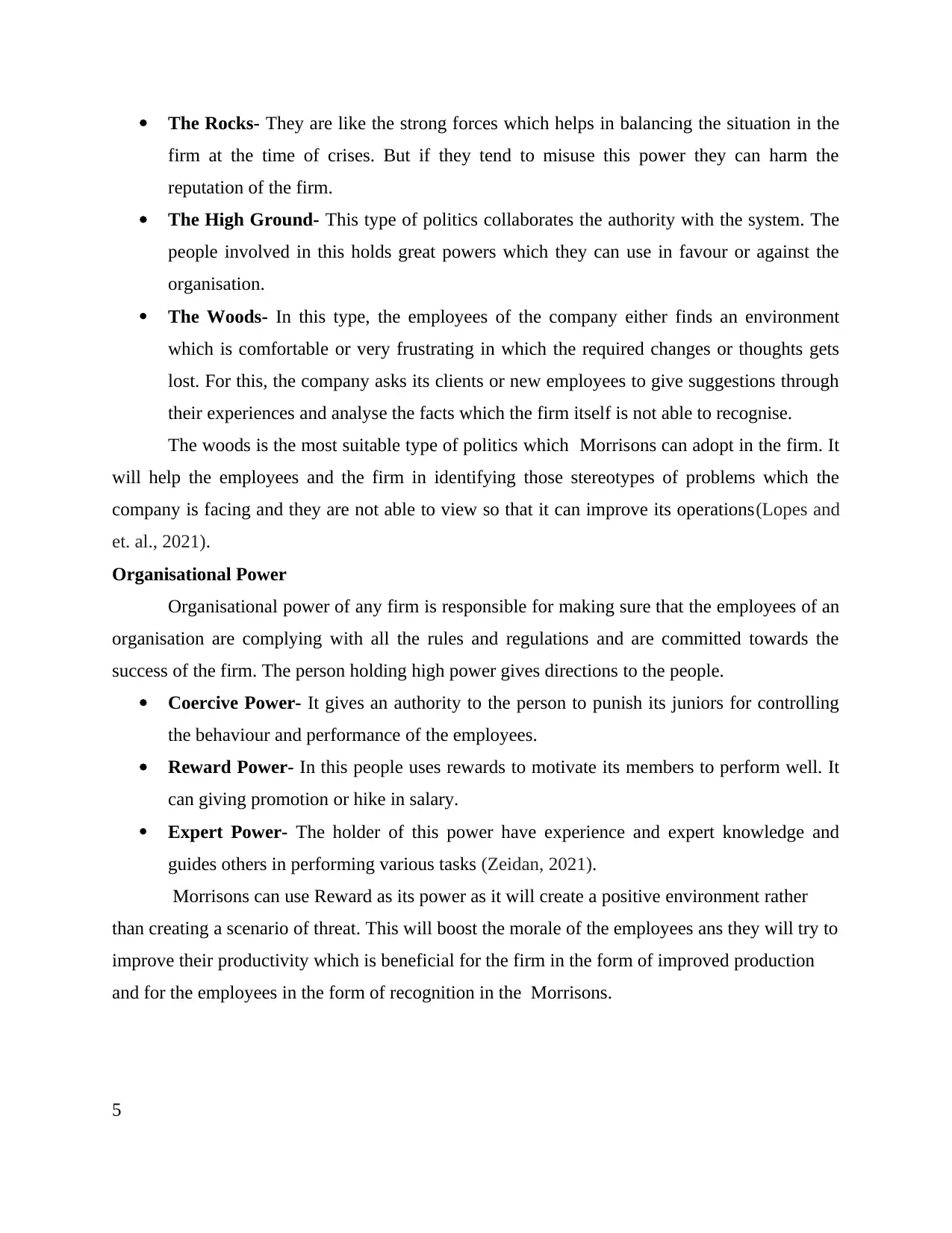
The Rocks- They are like the strong forces which helps in balancing the situation in the
firm at the time of crises. But if they tend to misuse this power they can harm the
reputation of the firm.
The High Ground- This type of politics collaborates the authority with the system. The
people involved in this holds great powers which they can use in favour or against the
organisation.
The Woods- In this type, the employees of the company either finds an environment
which is comfortable or very frustrating in which the required changes or thoughts gets
lost. For this, the company asks its clients or new employees to give suggestions through
their experiences and analyse the facts which the firm itself is not able to recognise.
The woods is the most suitable type of politics which Morrisons can adopt in the firm. It
will help the employees and the firm in identifying those stereotypes of problems which the
company is facing and they are not able to view so that it can improve its operations(Lopes and
et. al., 2021).
Organisational Power
Organisational power of any firm is responsible for making sure that the employees of an
organisation are complying with all the rules and regulations and are committed towards the
success of the firm. The person holding high power gives directions to the people.
Coercive Power- It gives an authority to the person to punish its juniors for controlling
the behaviour and performance of the employees.
Reward Power- In this people uses rewards to motivate its members to perform well. It
can giving promotion or hike in salary.
Expert Power- The holder of this power have experience and expert knowledge and
guides others in performing various tasks (Zeidan, 2021).
Morrisons can use Reward as its power as it will create a positive environment rather
than creating a scenario of threat. This will boost the morale of the employees ans they will try to
improve their productivity which is beneficial for the firm in the form of improved production
and for the employees in the form of recognition in the Morrisons.
5
firm at the time of crises. But if they tend to misuse this power they can harm the
reputation of the firm.
The High Ground- This type of politics collaborates the authority with the system. The
people involved in this holds great powers which they can use in favour or against the
organisation.
The Woods- In this type, the employees of the company either finds an environment
which is comfortable or very frustrating in which the required changes or thoughts gets
lost. For this, the company asks its clients or new employees to give suggestions through
their experiences and analyse the facts which the firm itself is not able to recognise.
The woods is the most suitable type of politics which Morrisons can adopt in the firm. It
will help the employees and the firm in identifying those stereotypes of problems which the
company is facing and they are not able to view so that it can improve its operations(Lopes and
et. al., 2021).
Organisational Power
Organisational power of any firm is responsible for making sure that the employees of an
organisation are complying with all the rules and regulations and are committed towards the
success of the firm. The person holding high power gives directions to the people.
Coercive Power- It gives an authority to the person to punish its juniors for controlling
the behaviour and performance of the employees.
Reward Power- In this people uses rewards to motivate its members to perform well. It
can giving promotion or hike in salary.
Expert Power- The holder of this power have experience and expert knowledge and
guides others in performing various tasks (Zeidan, 2021).
Morrisons can use Reward as its power as it will create a positive environment rather
than creating a scenario of threat. This will boost the morale of the employees ans they will try to
improve their productivity which is beneficial for the firm in the form of improved production
and for the employees in the form of recognition in the Morrisons.
5
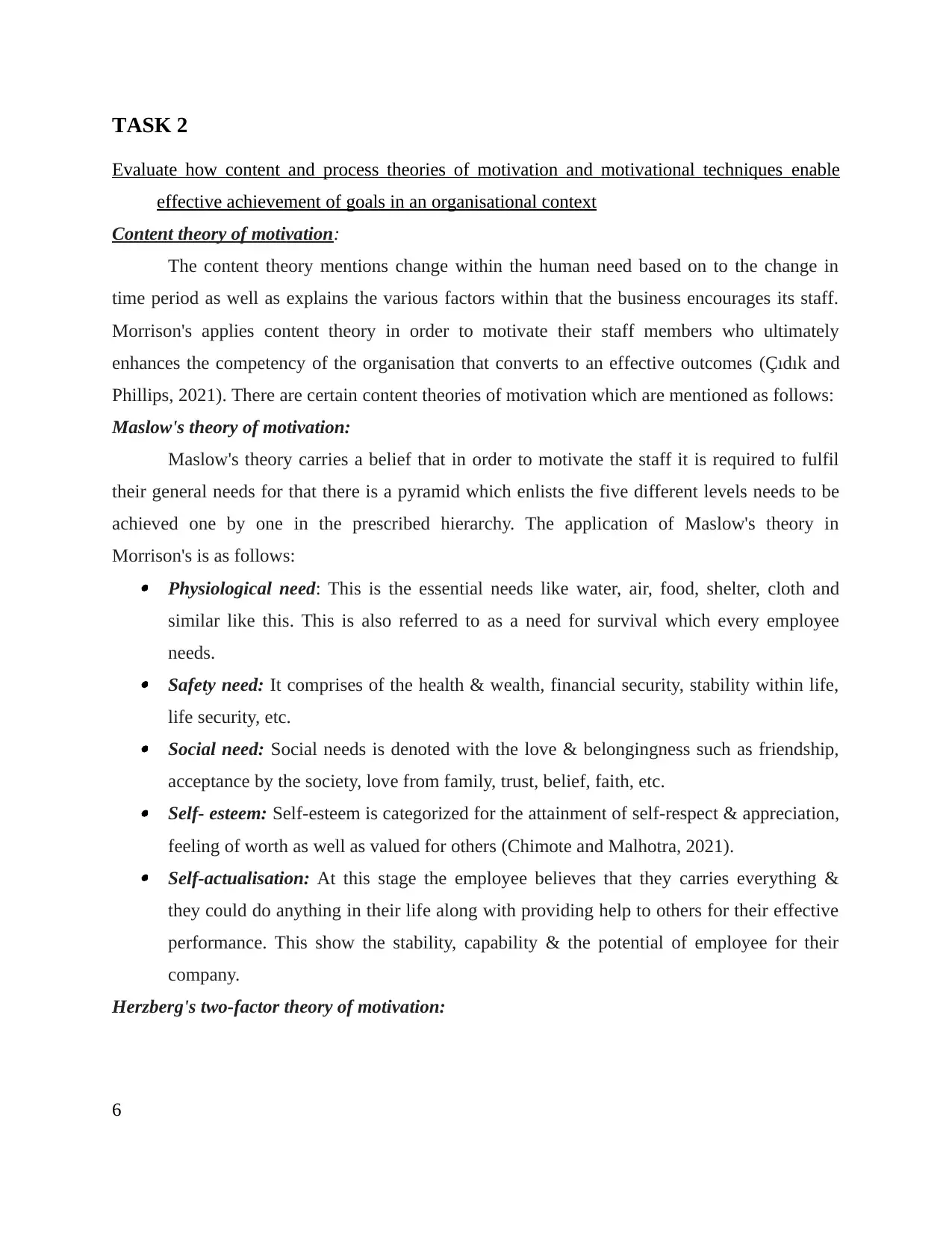
TASK 2
Evaluate how content and process theories of motivation and motivational techniques enable
effective achievement of goals in an organisational context
Content theory of motivation:
The content theory mentions change within the human need based on to the change in
time period as well as explains the various factors within that the business encourages its staff.
Morrison's applies content theory in order to motivate their staff members who ultimately
enhances the competency of the organisation that converts to an effective outcomes (Çıdık and
Phillips, 2021). There are certain content theories of motivation which are mentioned as follows:
Maslow's theory of motivation:
Maslow's theory carries a belief that in order to motivate the staff it is required to fulfil
their general needs for that there is a pyramid which enlists the five different levels needs to be
achieved one by one in the prescribed hierarchy. The application of Maslow's theory in
Morrison's is as follows: Physiological need: This is the essential needs like water, air, food, shelter, cloth and
similar like this. This is also referred to as a need for survival which every employee
needs. Safety need: It comprises of the health & wealth, financial security, stability within life,
life security, etc. Social need: Social needs is denoted with the love & belongingness such as friendship,
acceptance by the society, love from family, trust, belief, faith, etc. Self- esteem: Self-esteem is categorized for the attainment of self-respect & appreciation,
feeling of worth as well as valued for others (Chimote and Malhotra, 2021). Self-actualisation: At this stage the employee believes that they carries everything &
they could do anything in their life along with providing help to others for their effective
performance. This show the stability, capability & the potential of employee for their
company.
Herzberg's two-factor theory of motivation:
6
Evaluate how content and process theories of motivation and motivational techniques enable
effective achievement of goals in an organisational context
Content theory of motivation:
The content theory mentions change within the human need based on to the change in
time period as well as explains the various factors within that the business encourages its staff.
Morrison's applies content theory in order to motivate their staff members who ultimately
enhances the competency of the organisation that converts to an effective outcomes (Çıdık and
Phillips, 2021). There are certain content theories of motivation which are mentioned as follows:
Maslow's theory of motivation:
Maslow's theory carries a belief that in order to motivate the staff it is required to fulfil
their general needs for that there is a pyramid which enlists the five different levels needs to be
achieved one by one in the prescribed hierarchy. The application of Maslow's theory in
Morrison's is as follows: Physiological need: This is the essential needs like water, air, food, shelter, cloth and
similar like this. This is also referred to as a need for survival which every employee
needs. Safety need: It comprises of the health & wealth, financial security, stability within life,
life security, etc. Social need: Social needs is denoted with the love & belongingness such as friendship,
acceptance by the society, love from family, trust, belief, faith, etc. Self- esteem: Self-esteem is categorized for the attainment of self-respect & appreciation,
feeling of worth as well as valued for others (Chimote and Malhotra, 2021). Self-actualisation: At this stage the employee believes that they carries everything &
they could do anything in their life along with providing help to others for their effective
performance. This show the stability, capability & the potential of employee for their
company.
Herzberg's two-factor theory of motivation:
6
⊘ This is a preview!⊘
Do you want full access?
Subscribe today to unlock all pages.

Trusted by 1+ million students worldwide
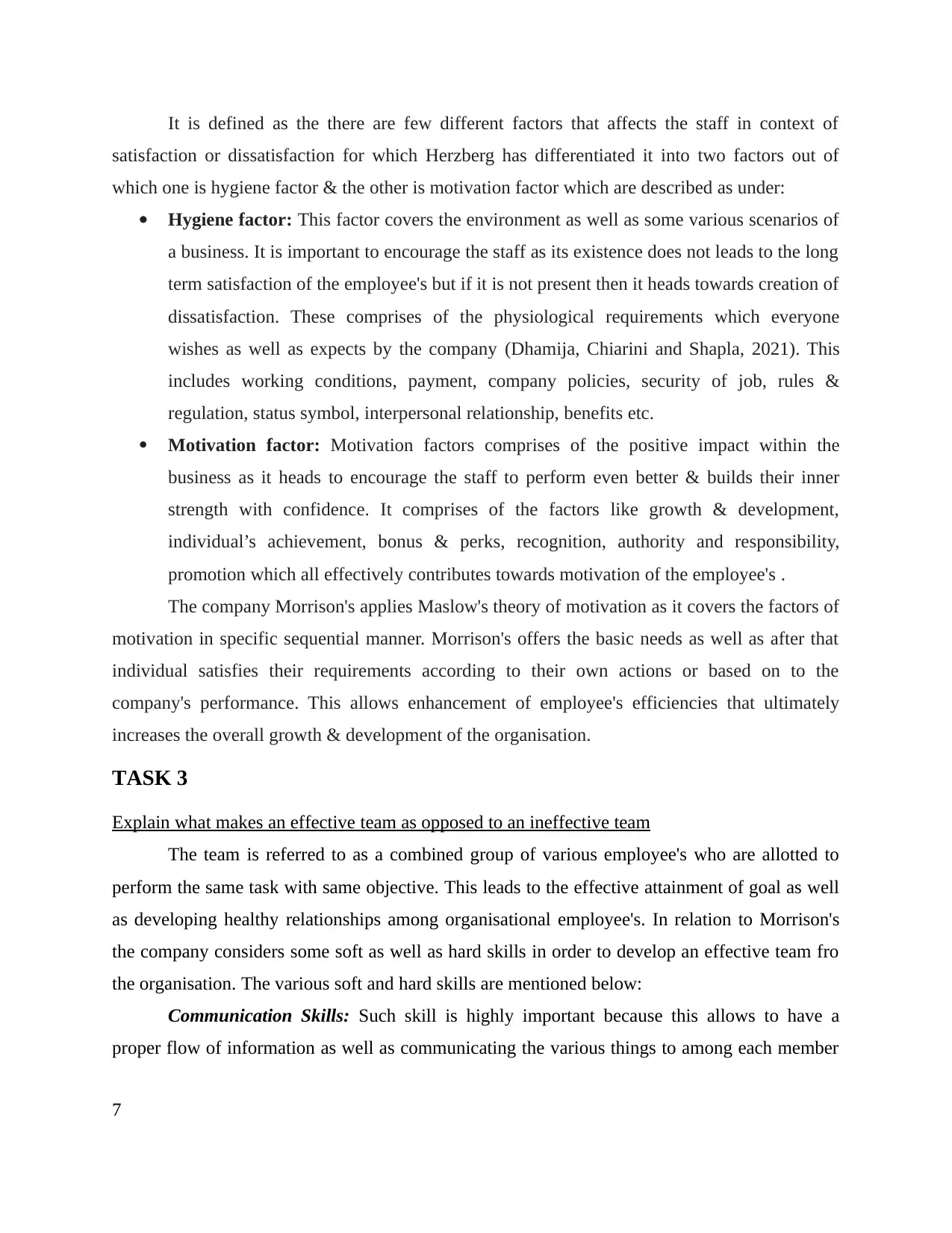
It is defined as the there are few different factors that affects the staff in context of
satisfaction or dissatisfaction for which Herzberg has differentiated it into two factors out of
which one is hygiene factor & the other is motivation factor which are described as under:
Hygiene factor: This factor covers the environment as well as some various scenarios of
a business. It is important to encourage the staff as its existence does not leads to the long
term satisfaction of the employee's but if it is not present then it heads towards creation of
dissatisfaction. These comprises of the physiological requirements which everyone
wishes as well as expects by the company (Dhamija, Chiarini and Shapla, 2021). This
includes working conditions, payment, company policies, security of job, rules &
regulation, status symbol, interpersonal relationship, benefits etc.
Motivation factor: Motivation factors comprises of the positive impact within the
business as it heads to encourage the staff to perform even better & builds their inner
strength with confidence. It comprises of the factors like growth & development,
individual’s achievement, bonus & perks, recognition, authority and responsibility,
promotion which all effectively contributes towards motivation of the employee's .
The company Morrison's applies Maslow's theory of motivation as it covers the factors of
motivation in specific sequential manner. Morrison's offers the basic needs as well as after that
individual satisfies their requirements according to their own actions or based on to the
company's performance. This allows enhancement of employee's efficiencies that ultimately
increases the overall growth & development of the organisation.
TASK 3
Explain what makes an effective team as opposed to an ineffective team
The team is referred to as a combined group of various employee's who are allotted to
perform the same task with same objective. This leads to the effective attainment of goal as well
as developing healthy relationships among organisational employee's. In relation to Morrison's
the company considers some soft as well as hard skills in order to develop an effective team fro
the organisation. The various soft and hard skills are mentioned below:
Communication Skills: Such skill is highly important because this allows to have a
proper flow of information as well as communicating the various things to among each member
7
satisfaction or dissatisfaction for which Herzberg has differentiated it into two factors out of
which one is hygiene factor & the other is motivation factor which are described as under:
Hygiene factor: This factor covers the environment as well as some various scenarios of
a business. It is important to encourage the staff as its existence does not leads to the long
term satisfaction of the employee's but if it is not present then it heads towards creation of
dissatisfaction. These comprises of the physiological requirements which everyone
wishes as well as expects by the company (Dhamija, Chiarini and Shapla, 2021). This
includes working conditions, payment, company policies, security of job, rules &
regulation, status symbol, interpersonal relationship, benefits etc.
Motivation factor: Motivation factors comprises of the positive impact within the
business as it heads to encourage the staff to perform even better & builds their inner
strength with confidence. It comprises of the factors like growth & development,
individual’s achievement, bonus & perks, recognition, authority and responsibility,
promotion which all effectively contributes towards motivation of the employee's .
The company Morrison's applies Maslow's theory of motivation as it covers the factors of
motivation in specific sequential manner. Morrison's offers the basic needs as well as after that
individual satisfies their requirements according to their own actions or based on to the
company's performance. This allows enhancement of employee's efficiencies that ultimately
increases the overall growth & development of the organisation.
TASK 3
Explain what makes an effective team as opposed to an ineffective team
The team is referred to as a combined group of various employee's who are allotted to
perform the same task with same objective. This leads to the effective attainment of goal as well
as developing healthy relationships among organisational employee's. In relation to Morrison's
the company considers some soft as well as hard skills in order to develop an effective team fro
the organisation. The various soft and hard skills are mentioned below:
Communication Skills: Such skill is highly important because this allows to have a
proper flow of information as well as communicating the various things to among each member
7
Paraphrase This Document
Need a fresh take? Get an instant paraphrase of this document with our AI Paraphraser
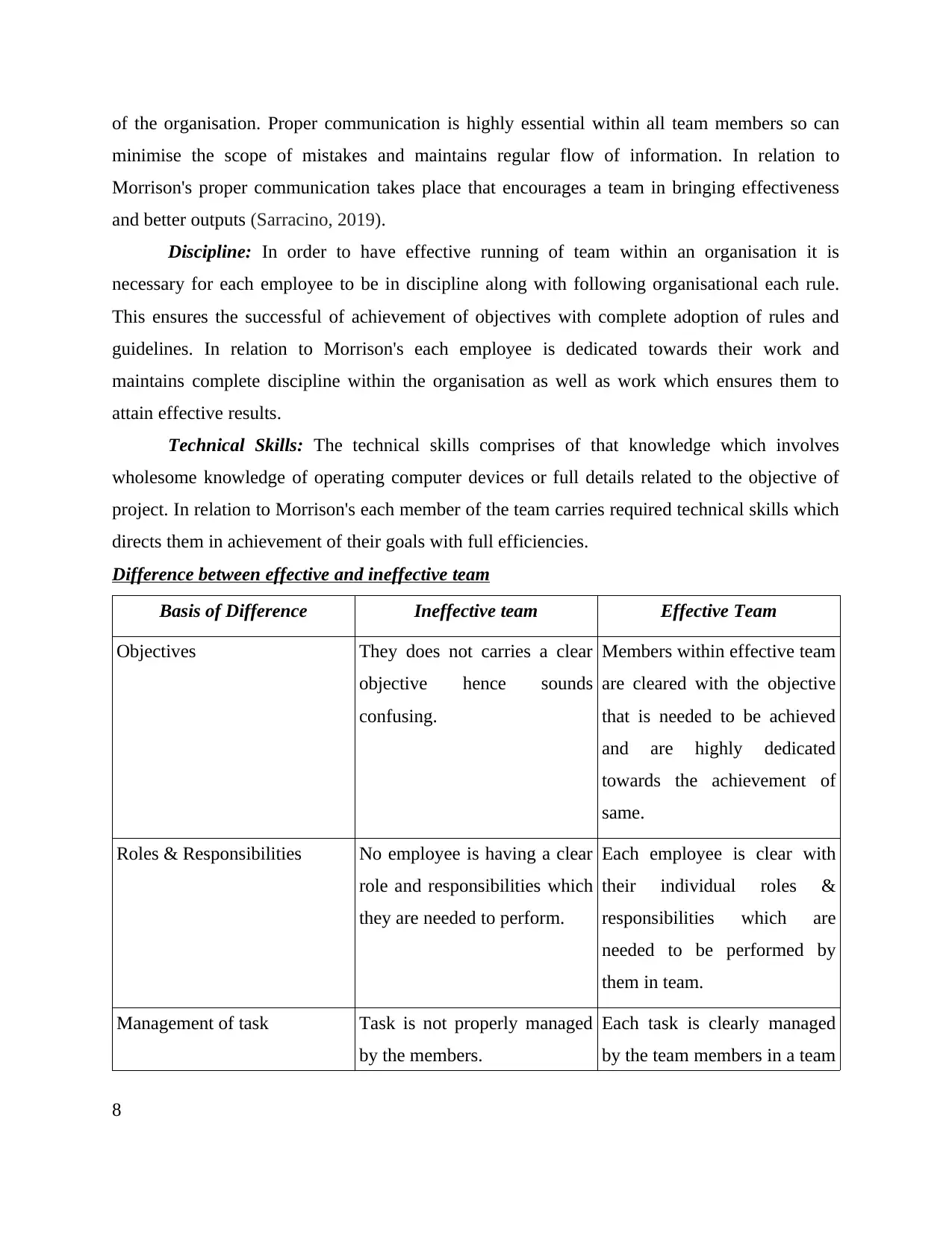
of the organisation. Proper communication is highly essential within all team members so can
minimise the scope of mistakes and maintains regular flow of information. In relation to
Morrison's proper communication takes place that encourages a team in bringing effectiveness
and better outputs (Sarracino, 2019).
Discipline: In order to have effective running of team within an organisation it is
necessary for each employee to be in discipline along with following organisational each rule.
This ensures the successful of achievement of objectives with complete adoption of rules and
guidelines. In relation to Morrison's each employee is dedicated towards their work and
maintains complete discipline within the organisation as well as work which ensures them to
attain effective results.
Technical Skills: The technical skills comprises of that knowledge which involves
wholesome knowledge of operating computer devices or full details related to the objective of
project. In relation to Morrison's each member of the team carries required technical skills which
directs them in achievement of their goals with full efficiencies.
Difference between effective and ineffective team
Basis of Difference Ineffective team Effective Team
Objectives They does not carries a clear
objective hence sounds
confusing.
Members within effective team
are cleared with the objective
that is needed to be achieved
and are highly dedicated
towards the achievement of
same.
Roles & Responsibilities No employee is having a clear
role and responsibilities which
they are needed to perform.
Each employee is clear with
their individual roles &
responsibilities which are
needed to be performed by
them in team.
Management of task Task is not properly managed
by the members.
Each task is clearly managed
by the team members in a team
8
minimise the scope of mistakes and maintains regular flow of information. In relation to
Morrison's proper communication takes place that encourages a team in bringing effectiveness
and better outputs (Sarracino, 2019).
Discipline: In order to have effective running of team within an organisation it is
necessary for each employee to be in discipline along with following organisational each rule.
This ensures the successful of achievement of objectives with complete adoption of rules and
guidelines. In relation to Morrison's each employee is dedicated towards their work and
maintains complete discipline within the organisation as well as work which ensures them to
attain effective results.
Technical Skills: The technical skills comprises of that knowledge which involves
wholesome knowledge of operating computer devices or full details related to the objective of
project. In relation to Morrison's each member of the team carries required technical skills which
directs them in achievement of their goals with full efficiencies.
Difference between effective and ineffective team
Basis of Difference Ineffective team Effective Team
Objectives They does not carries a clear
objective hence sounds
confusing.
Members within effective team
are cleared with the objective
that is needed to be achieved
and are highly dedicated
towards the achievement of
same.
Roles & Responsibilities No employee is having a clear
role and responsibilities which
they are needed to perform.
Each employee is clear with
their individual roles &
responsibilities which are
needed to be performed by
them in team.
Management of task Task is not properly managed
by the members.
Each task is clearly managed
by the team members in a team
8
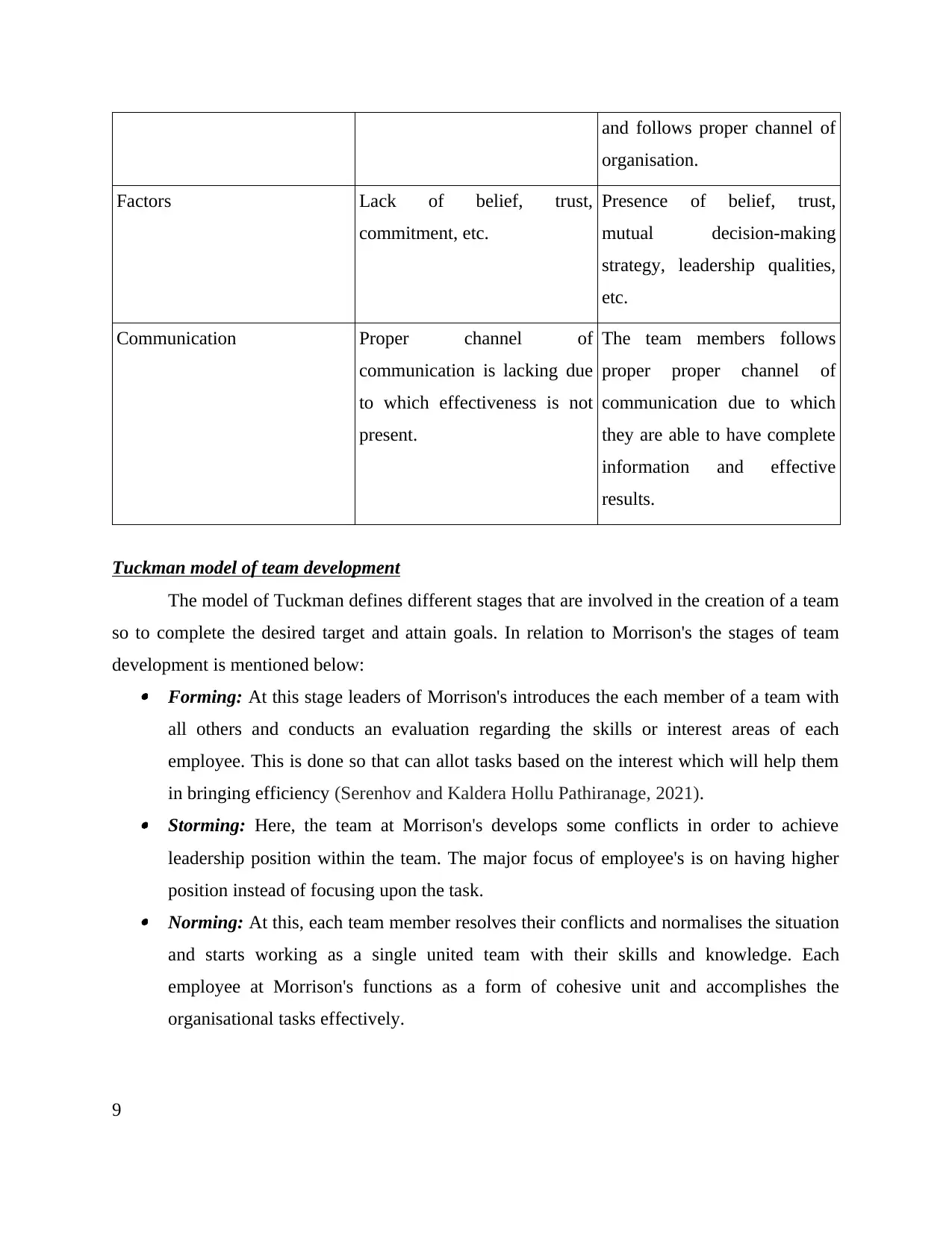
and follows proper channel of
organisation.
Factors Lack of belief, trust,
commitment, etc.
Presence of belief, trust,
mutual decision-making
strategy, leadership qualities,
etc.
Communication Proper channel of
communication is lacking due
to which effectiveness is not
present.
The team members follows
proper proper channel of
communication due to which
they are able to have complete
information and effective
results.
Tuckman model of team development
The model of Tuckman defines different stages that are involved in the creation of a team
so to complete the desired target and attain goals. In relation to Morrison's the stages of team
development is mentioned below: Forming: At this stage leaders of Morrison's introduces the each member of a team with
all others and conducts an evaluation regarding the skills or interest areas of each
employee. This is done so that can allot tasks based on the interest which will help them
in bringing efficiency (Serenhov and Kaldera Hollu Pathiranage, 2021). Storming: Here, the team at Morrison's develops some conflicts in order to achieve
leadership position within the team. The major focus of employee's is on having higher
position instead of focusing upon the task. Norming: At this, each team member resolves their conflicts and normalises the situation
and starts working as a single united team with their skills and knowledge. Each
employee at Morrison's functions as a form of cohesive unit and accomplishes the
organisational tasks effectively.
9
organisation.
Factors Lack of belief, trust,
commitment, etc.
Presence of belief, trust,
mutual decision-making
strategy, leadership qualities,
etc.
Communication Proper channel of
communication is lacking due
to which effectiveness is not
present.
The team members follows
proper proper channel of
communication due to which
they are able to have complete
information and effective
results.
Tuckman model of team development
The model of Tuckman defines different stages that are involved in the creation of a team
so to complete the desired target and attain goals. In relation to Morrison's the stages of team
development is mentioned below: Forming: At this stage leaders of Morrison's introduces the each member of a team with
all others and conducts an evaluation regarding the skills or interest areas of each
employee. This is done so that can allot tasks based on the interest which will help them
in bringing efficiency (Serenhov and Kaldera Hollu Pathiranage, 2021). Storming: Here, the team at Morrison's develops some conflicts in order to achieve
leadership position within the team. The major focus of employee's is on having higher
position instead of focusing upon the task. Norming: At this, each team member resolves their conflicts and normalises the situation
and starts working as a single united team with their skills and knowledge. Each
employee at Morrison's functions as a form of cohesive unit and accomplishes the
organisational tasks effectively.
9
⊘ This is a preview!⊘
Do you want full access?
Subscribe today to unlock all pages.

Trusted by 1+ million students worldwide
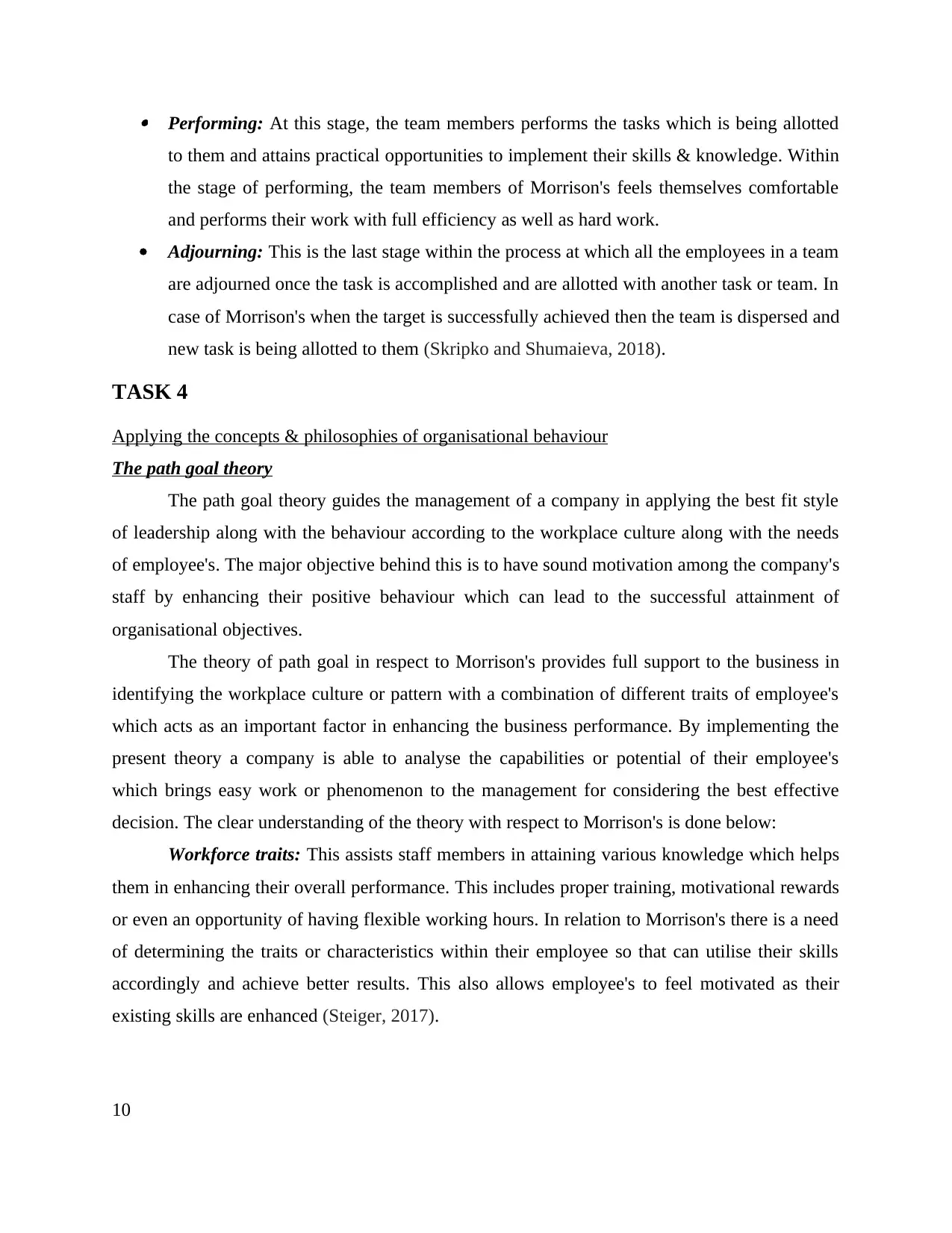
Performing: At this stage, the team members performs the tasks which is being allotted
to them and attains practical opportunities to implement their skills & knowledge. Within
the stage of performing, the team members of Morrison's feels themselves comfortable
and performs their work with full efficiency as well as hard work.
Adjourning: This is the last stage within the process at which all the employees in a team
are adjourned once the task is accomplished and are allotted with another task or team. In
case of Morrison's when the target is successfully achieved then the team is dispersed and
new task is being allotted to them (Skripko and Shumaieva, 2018).
TASK 4
Applying the concepts & philosophies of organisational behaviour
The path goal theory
The path goal theory guides the management of a company in applying the best fit style
of leadership along with the behaviour according to the workplace culture along with the needs
of employee's. The major objective behind this is to have sound motivation among the company's
staff by enhancing their positive behaviour which can lead to the successful attainment of
organisational objectives.
The theory of path goal in respect to Morrison's provides full support to the business in
identifying the workplace culture or pattern with a combination of different traits of employee's
which acts as an important factor in enhancing the business performance. By implementing the
present theory a company is able to analyse the capabilities or potential of their employee's
which brings easy work or phenomenon to the management for considering the best effective
decision. The clear understanding of the theory with respect to Morrison's is done below:
Workforce traits: This assists staff members in attaining various knowledge which helps
them in enhancing their overall performance. This includes proper training, motivational rewards
or even an opportunity of having flexible working hours. In relation to Morrison's there is a need
of determining the traits or characteristics within their employee so that can utilise their skills
accordingly and achieve better results. This also allows employee's to feel motivated as their
existing skills are enhanced (Steiger, 2017).
10
to them and attains practical opportunities to implement their skills & knowledge. Within
the stage of performing, the team members of Morrison's feels themselves comfortable
and performs their work with full efficiency as well as hard work.
Adjourning: This is the last stage within the process at which all the employees in a team
are adjourned once the task is accomplished and are allotted with another task or team. In
case of Morrison's when the target is successfully achieved then the team is dispersed and
new task is being allotted to them (Skripko and Shumaieva, 2018).
TASK 4
Applying the concepts & philosophies of organisational behaviour
The path goal theory
The path goal theory guides the management of a company in applying the best fit style
of leadership along with the behaviour according to the workplace culture along with the needs
of employee's. The major objective behind this is to have sound motivation among the company's
staff by enhancing their positive behaviour which can lead to the successful attainment of
organisational objectives.
The theory of path goal in respect to Morrison's provides full support to the business in
identifying the workplace culture or pattern with a combination of different traits of employee's
which acts as an important factor in enhancing the business performance. By implementing the
present theory a company is able to analyse the capabilities or potential of their employee's
which brings easy work or phenomenon to the management for considering the best effective
decision. The clear understanding of the theory with respect to Morrison's is done below:
Workforce traits: This assists staff members in attaining various knowledge which helps
them in enhancing their overall performance. This includes proper training, motivational rewards
or even an opportunity of having flexible working hours. In relation to Morrison's there is a need
of determining the traits or characteristics within their employee so that can utilise their skills
accordingly and achieve better results. This also allows employee's to feel motivated as their
existing skills are enhanced (Steiger, 2017).
10
Paraphrase This Document
Need a fresh take? Get an instant paraphrase of this document with our AI Paraphraser
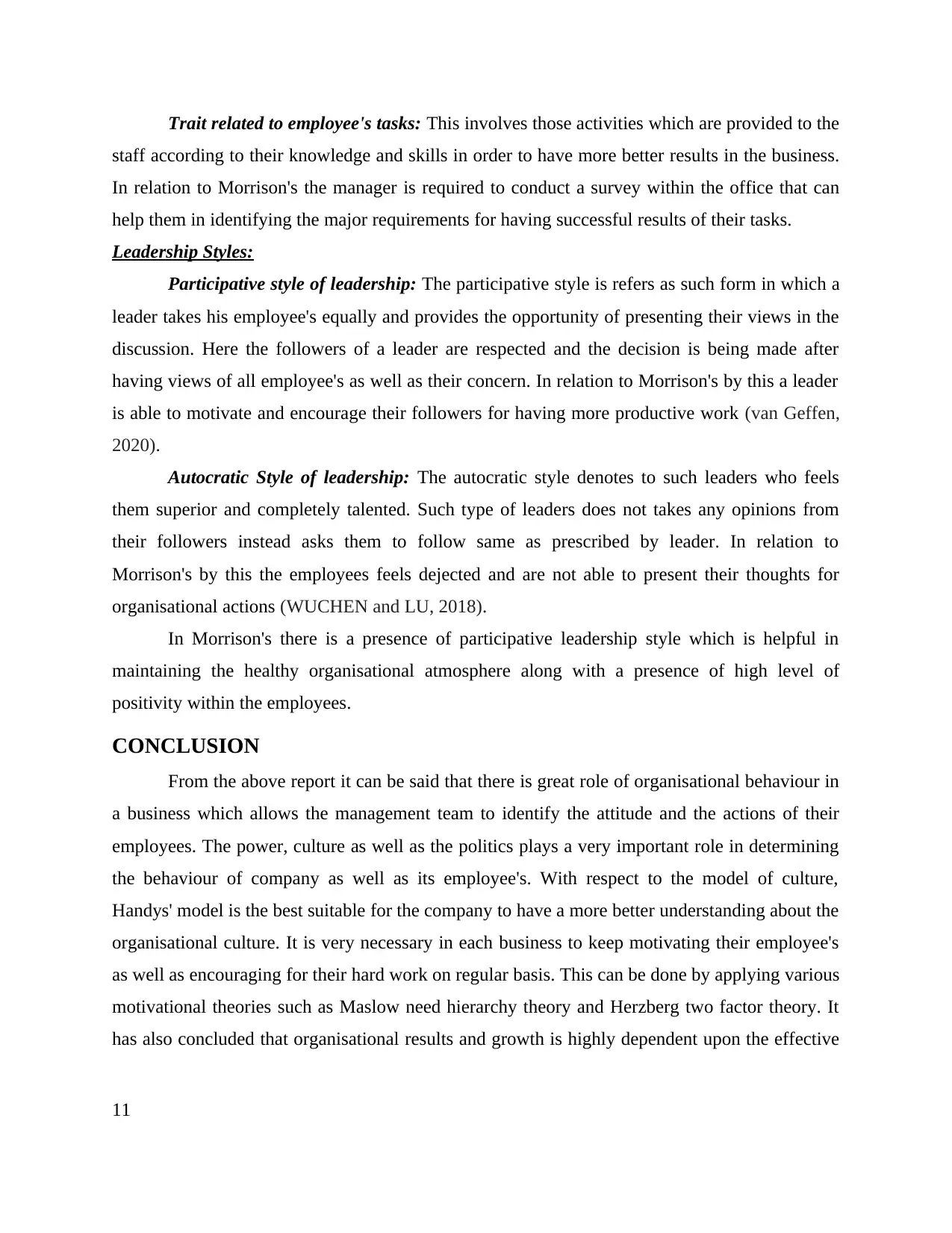
Trait related to employee's tasks: This involves those activities which are provided to the
staff according to their knowledge and skills in order to have more better results in the business.
In relation to Morrison's the manager is required to conduct a survey within the office that can
help them in identifying the major requirements for having successful results of their tasks.
Leadership Styles:
Participative style of leadership: The participative style is refers as such form in which a
leader takes his employee's equally and provides the opportunity of presenting their views in the
discussion. Here the followers of a leader are respected and the decision is being made after
having views of all employee's as well as their concern. In relation to Morrison's by this a leader
is able to motivate and encourage their followers for having more productive work (van Geffen,
2020).
Autocratic Style of leadership: The autocratic style denotes to such leaders who feels
them superior and completely talented. Such type of leaders does not takes any opinions from
their followers instead asks them to follow same as prescribed by leader. In relation to
Morrison's by this the employees feels dejected and are not able to present their thoughts for
organisational actions (WUCHEN and LU, 2018).
In Morrison's there is a presence of participative leadership style which is helpful in
maintaining the healthy organisational atmosphere along with a presence of high level of
positivity within the employees.
CONCLUSION
From the above report it can be said that there is great role of organisational behaviour in
a business which allows the management team to identify the attitude and the actions of their
employees. The power, culture as well as the politics plays a very important role in determining
the behaviour of company as well as its employee's. With respect to the model of culture,
Handys' model is the best suitable for the company to have a more better understanding about the
organisational culture. It is very necessary in each business to keep motivating their employee's
as well as encouraging for their hard work on regular basis. This can be done by applying various
motivational theories such as Maslow need hierarchy theory and Herzberg two factor theory. It
has also concluded that organisational results and growth is highly dependent upon the effective
11
staff according to their knowledge and skills in order to have more better results in the business.
In relation to Morrison's the manager is required to conduct a survey within the office that can
help them in identifying the major requirements for having successful results of their tasks.
Leadership Styles:
Participative style of leadership: The participative style is refers as such form in which a
leader takes his employee's equally and provides the opportunity of presenting their views in the
discussion. Here the followers of a leader are respected and the decision is being made after
having views of all employee's as well as their concern. In relation to Morrison's by this a leader
is able to motivate and encourage their followers for having more productive work (van Geffen,
2020).
Autocratic Style of leadership: The autocratic style denotes to such leaders who feels
them superior and completely talented. Such type of leaders does not takes any opinions from
their followers instead asks them to follow same as prescribed by leader. In relation to
Morrison's by this the employees feels dejected and are not able to present their thoughts for
organisational actions (WUCHEN and LU, 2018).
In Morrison's there is a presence of participative leadership style which is helpful in
maintaining the healthy organisational atmosphere along with a presence of high level of
positivity within the employees.
CONCLUSION
From the above report it can be said that there is great role of organisational behaviour in
a business which allows the management team to identify the attitude and the actions of their
employees. The power, culture as well as the politics plays a very important role in determining
the behaviour of company as well as its employee's. With respect to the model of culture,
Handys' model is the best suitable for the company to have a more better understanding about the
organisational culture. It is very necessary in each business to keep motivating their employee's
as well as encouraging for their hard work on regular basis. This can be done by applying various
motivational theories such as Maslow need hierarchy theory and Herzberg two factor theory. It
has also concluded that organisational results and growth is highly dependent upon the effective
11
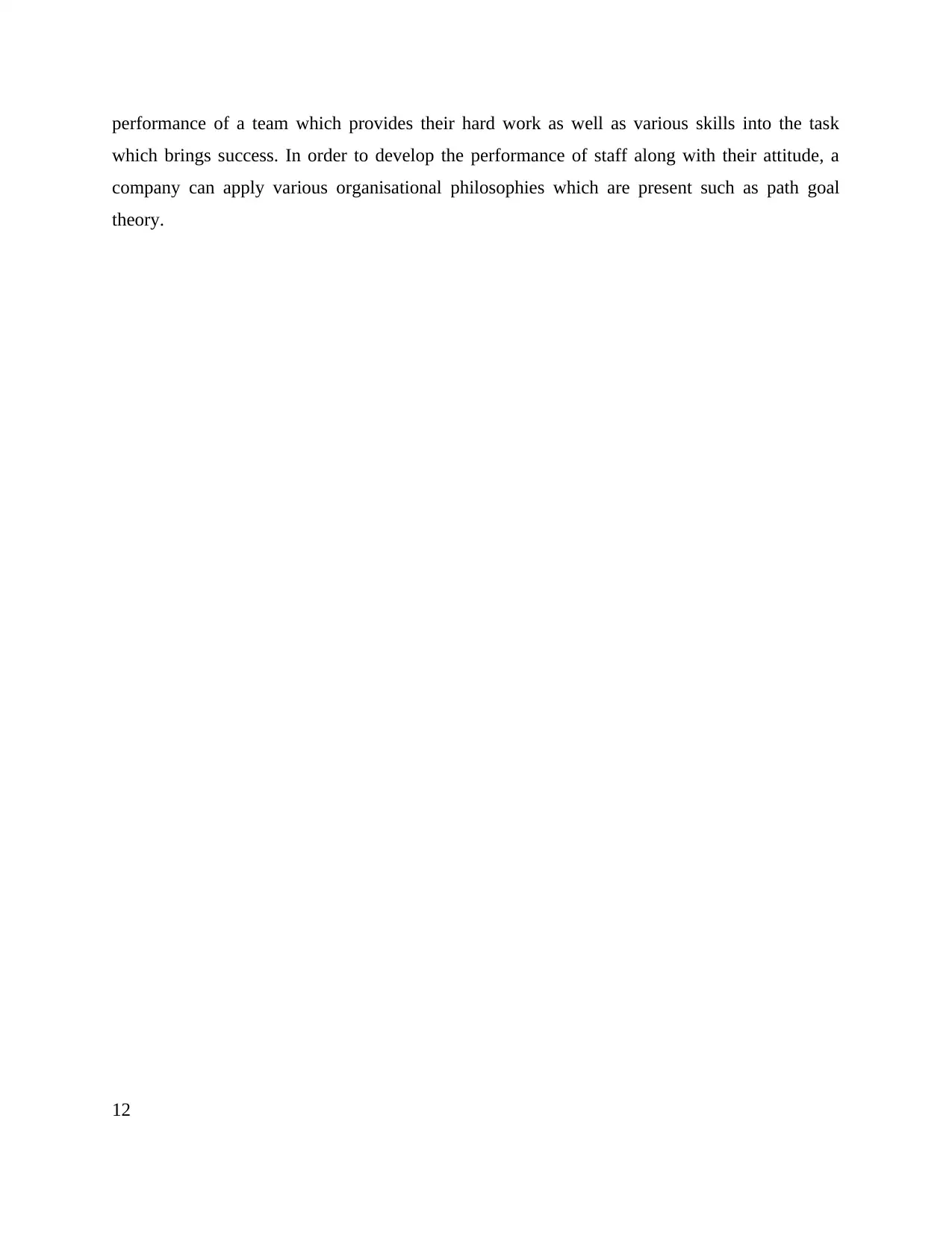
performance of a team which provides their hard work as well as various skills into the task
which brings success. In order to develop the performance of staff along with their attitude, a
company can apply various organisational philosophies which are present such as path goal
theory.
12
which brings success. In order to develop the performance of staff along with their attitude, a
company can apply various organisational philosophies which are present such as path goal
theory.
12
⊘ This is a preview!⊘
Do you want full access?
Subscribe today to unlock all pages.

Trusted by 1+ million students worldwide
1 out of 14
Related Documents
Your All-in-One AI-Powered Toolkit for Academic Success.
+13062052269
info@desklib.com
Available 24*7 on WhatsApp / Email
![[object Object]](/_next/static/media/star-bottom.7253800d.svg)
Unlock your academic potential
Copyright © 2020–2025 A2Z Services. All Rights Reserved. Developed and managed by ZUCOL.



